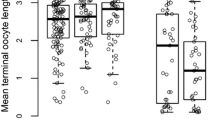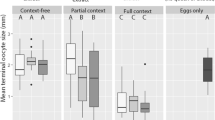Abstract
We tested the hypotheses that a non-volatile pheromone inhibiting worker egg-laying and queen development produced by Bombus terrestris queens has effects transferable (a) from workers to other workers or larvae, or (b) on wax. We subdivided small, young colonies with a single mesh screen (Experiment 1) and larger, older colonies with a double mesh screen (Experiment 2). One treatment (in both experiments) involved the transfer of workers, and one treatment (in Experiment 2 only) involved the transfer of wax, from the queenright to the queenless compartments. Queenlessness induced significantly earlier onset of worker aggression (followed by egg-laying) in all treatments in both experiments, and significantly earlier queen production in all treatments in Experiment 2 (small colony sizes probably hindered queen production in Experiment 1). These findings suggested that the effects of B. terrestris queen pheromone are not transferable via workers or wax.
Zusammenfassung
Es gibt deutliche Hinweise, dass die Königinnen der Hummel Bombus terrestris L. sowohl die Eilage von Arbeiterinnen als auch die Entwicklung von weiblichen Larven zu neuen Königinnen mittels eines oder mehrerer nichtflüchtiger Pheromone hemmen. Diese Hemmung endet mit oder in etwa mit dem ’Kompetitionspunkt’, an dem die Arbeiterinnen mit Aggression und Eilage beginnen und nach dem weibliche Larven sich zu Königinnen entwickeln. Unter Verwendung von geteilten Völkern testeten wir zwei Hypothesen. Die erste war, dass die Auswirkungen der Königinnenpheromone von Arbeiterinnen auf andere Arbeiterinnen oder Larven übertragen werden können. Die zweite war, dass diese auf Wachs übertragen werden können. Wir verglichen die Zeit des Kompetitionspunktes (definiert als den Beginn der Arbeiterinnenaggressivität, der von Eilage gefolgt wird) und die Produktion von Königinnen zwischen den weiselrichtigen und weisellosen Abteilen von durch ein einfaches Gitter unterteilten kleinen jungen Völkern (Experiment 1) und von mit einem doppelten Gitter unterteilten großen älteren Völkern (Experiment 2). In beiden Experimenten wurden in einer der Versuchsgruppen Arbeiterinnen von den weiselrichtigen in die weisellose Abteilung übertragen. In dem zweiten Experiment wurde zusätzlich in einer der Versuchsgruppen Wachs übertragen. Allerdings fanden wir, dass bei Weisellosigkeit der Kompetitionspunkt wesentlich früher erreicht wurde, und (außer in Experiment 1, in dem in weisellosen Völkern keine oder nur sehr wenige Königinnen erzeugt wurden) dass der Beginn der Königinnenproduktion signifikant früher war, völlig unabhängig davon ob Arbeiterinnen oder Wachs übertragen worden waren (Tab. II und III). Daher ist es unwahrscheinlich, dass Königinnenpheromon oder Pheromone über Arbeiterinnen oder Wachs verteilt werden, und es bleibt eine offene Frage, durch welchen Mechanismus der Effekt der Pheromone von der Königin zu den Arbeiterinnen oder Larven gelangt. Darüber hinaus hing in Bezug auf die Königinnenproduktion der Einfluss der Weisellosigkeit von der Koloniegröße und Reife ab, was einen Einfluss des Sozialkontext auf die Reaktion von B. terrestris auf die Experimentalbedingungen belegt.
Similar content being viewed by others
References
Alaux C., Jaisson P., Hefetz A. (2004) Queen influence on worker reproduction in bumblebees (Bombus terrestris) colonies, Insect. Soc. 51, 287–293.
Alaux C., Jaisson P., Hefetz A. (2005) Reproductive decision-making in semelparous colonies of the bumblebee Bombus terrestris, Behav. Ecol. Sociobiol. 59, 270–277.
Alaux C., Jaisson P., Hefetz A. (2006) Regulation of worker reproduction in bumblebees (Bombus terrestris): workers eavesdrop on a queen signal, Behav. Ecol. Sociobiol. 60, 439–446.
Beekman M., Van Stratum P. (1998) Bumblebee sex ratios: why do bumblebees produce so many males? Proc. R. Soc. Lond. B 265, 1535–1543.
Bloch G. (1999) Regulation of queen-worker conflict in bumble-bee (Bombus terrestris) colonies, Proc. R. Soc. Lond. B 266, 2465–2469.
Bloch G., Hefetz A. (1999a) Regulation of reproduction by dominant workers in bumblebee (Bombus terrestris) queenright colonies, Behav. Ecol. Sociobiol. 45, 125–135.
Bloch G., Hefetz A. (1999b) Reevaluation of the role of mandibular glands in regulation of reproduction in bumblebee colonies, J. Chem. Ecol. 25, 881–896.
Bloch G., Borst D.W., Huang Z.-Y., Robinson G.E., Hefetz A. (1996) Effects of social conditions on Juvenile Hormone mediated reproductive development in Bombus terrestris workers, Physiol. Entomol. 21, 257–267.
Bortolotti L., Duchateau M.J., Sbrenna G. (2001) Effect of juvenile hormone on caste determination and colony processes in the bumblebee Bombus terrestris, Entomol. Exp. Appl. 101, 143–158.
Bourke A.F.G., Ratnieks F.L.W. (2001) Kin-selected conflict in the bumble-bee Bombus terrestris (Hymenoptera: Apidae), Proc. R. Soc. Lond. B 268, 347–355.
Cnaani J., Borst D.W., Huang Z.Y., Robinson G.E., Hefetz A. (1997) Caste determination in Bombus terrestris: differences in development and rates of JH biosynthesis between queen and worker larvae, J. Insect Physiol. 43, 373–381.
Cnaani J., Robinson G.E., Bloch G., Borst D., Hefetz A. (2000) The effect of queen-worker conflict on caste determination in the bumblebee Bombus terrestris, Behav. Ecol. Sociobiol. 47, 346–352.
Crespi B.J. (1992) Cannibalism and trophic eggs in subsocial and eusocial insects, in: Elgar M.A., Crespi B.J. (Eds.), Cannibalism: ecology and evolution among diverse taxa, Oxford University Press, Oxford, pp. 176–213.
Duchateau M.J., Velthuis H.H.W. (1988) Development and reproductive strategies in Bombus terrestris colonies, Behaviour 107, 186–207.
Duchateau M.J., Velthuis H.H.W. (1989) Ovarian development and egg laying in workers of Bombus terrestris, Entomol. Exp. Appl. 51, 199–213.
Duchateau M.J., Velthuis H.H.W., Boomsma J.J. (2004) Sex ratio variation in the bumblebee Bombus terrestris, Behav. Ecol. 15, 71–82.
Endler A., Liebig J., Schmitt T., Parker J.E., Jones G.R., Schreier P., Hölldobler B. (2004) Surface hydrocarbons of queen eggs regulate worker reproduction in a social insect, Proc. Natl Acad. Sci. (USA) 101, 2945–2950.
Kukuk P.F. (1992) Cannibalism in social bees, in: Elgar M.A., Crespi B.J.. (Eds), Cannibalism: ecology and evolution among diverse taxa, Oxford University Press, Oxford, pp. 214–237.
Lopez-Vaamonde C., Koning J.W., Jordan W.C., Bourke A.F.G. (2003) No evidence that reproductive bumblebee workers reduce the production of new queens, Anim. Behav. 66, 577–584.
Naumann K., Winston M.L., Slessor K.N., Prestwich G.D., Webster E.X. (1991) Production and transmission of honey-bee queen (Apis mellifera L) mandibular gland pheromone, Behav. Ecol. Sociobiol. 29, 321–332.
Pereboom J.J.M. (2000) The composition of larval food and the significance of exocrine secretions in the bumblebee Bombus terrestris, Insect. Soc. 47, 11–20.
Pereboom J.J.M., Velthuis H.H.W., Duchateau M.J. (2003) The organisation of larval feeding in bumblebees (Hymenoptera, Apidae) and its significance to caste differentiation, Insect. Soc. 50, 127–133.
Ribeiro M.F., Velthuis H.H.W., Duchateau M.J., Van der Tweel I. (1999) Feeding frequency and caste differentiation in Bombus terrestris larvae, Insect. Soc. 46, 306–314.
Röseler P.-F. (1970) Unterschiede in der Kastendetermination zwischen den Hummelarten Bombus hypnorum und Bombus terrestris, Z. Naturforsch. B 25, 543–548.
Röseler P.-F. (1991) Roles of morphogenetic hormones in caste polymorphism in bumble bees, in: Gupta A.P. (Ed.), Morphogenetic hormones in arthropods, Rutgers University Press, New Brunswick, pp. 384–399.
Seeley T.D. (1985) Honeybee ecology, Princeton University Press, Princeton.
Author information
Authors and Affiliations
Corresponding author
Additional information
Manuscript editor: Stan Schneider
Rights and permissions
About this article
Cite this article
Lopez-Vaamonde, C., Brown, R.M., Lucas, E.R. et al. Effect of the queen on worker reproduction and new queen production in the bumble bee Bombus terrestris . Apidologie 38, 171–180 (2007). https://doi.org/10.1051/apido:2006070
Received:
Revised:
Accepted:
Issue Date:
DOI: https://doi.org/10.1051/apido:2006070




